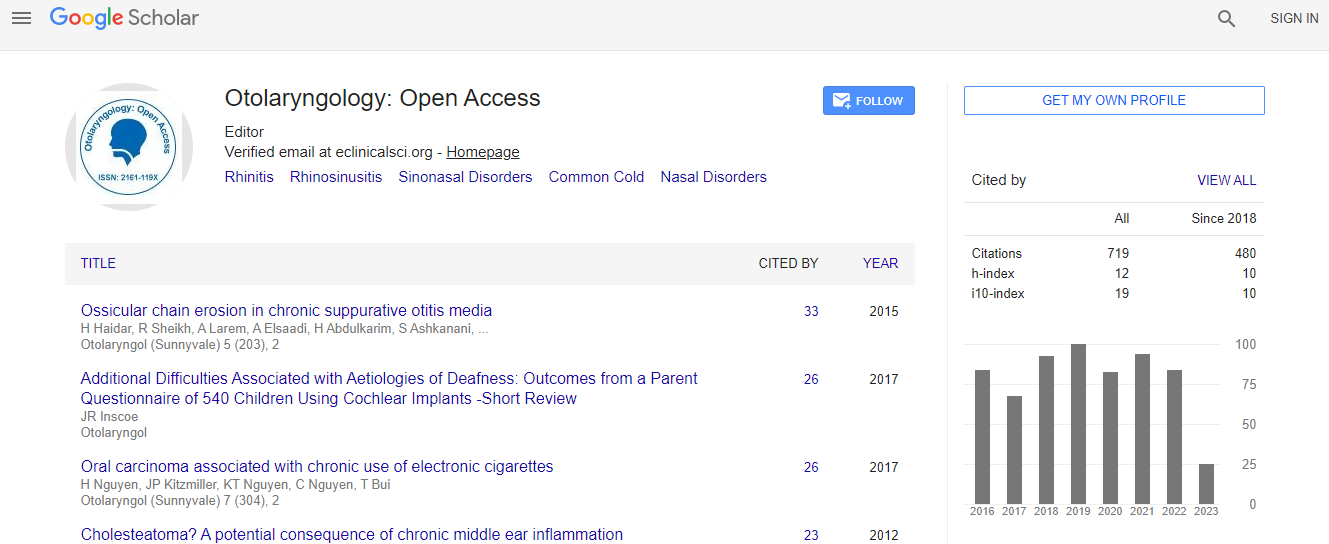Our Group organises 3000+ Global Conferenceseries Events every year across USA, Europe & Asia with support from 1000 more scientific Societies and Publishes 700+ Open Access Journals which contains over 50000 eminent personalities, reputed scientists as editorial board members.
Open Access Journals gaining more Readers and Citations
700 Journals and 15,000,000 Readers Each Journal is getting 25,000+ Readers
Google Scholar citation report
Citations : 925
Otolaryngology: Open Access received 925 citations as per Google Scholar report
Otolaryngology: Open Access peer review process verified at publons
Indexed In
- Index Copernicus
- Google Scholar
- Sherpa Romeo
- Open J Gate
- Genamics JournalSeek
- RefSeek
- Hamdard University
- EBSCO A-Z
- OCLC- WorldCat
- Publons
- Geneva Foundation for Medical Education and Research
- ICMJE
Useful Links
Recommended Journals
Related Subjects
Share This Page
Endoscopic surgery of the skull base and paranasal sinuses
International Conference and Exhibition on Otolaryngology
Ivan H El-Sayed
ScientificTracks Abstracts: Otolaryngology
Abstract
Since Ketcham�s landmark article on craniofacial resection in 1963 the field of skull base surgery has generated significant controversy. It took nearly 40 years to produce convincing data regarding safety and outcomes of open craniofacial resection for malignant disease. Over the past decade there has been a revolution in the management of paranasal sinus tumors with or without skull base involvement with introduction of endoscopic technology and expanded endonasal corridors allows surgical approach to lesions of the a paranasal sinuses, infratemporal fossa, anterior cranial fossa, sellar/suprasellar/infrasellar lesions, and the crainiocervical junction. Using a corridor concept to approach tumors, two surgeons can work with a four handed approach to dissect tumors while maintaining control of the surgical field. The proposed benefits of these techniques include improved cosmesis and potentially less morbid procedures due to reduced brain retraction, blood loss, and a smaller wound. Critics of these techniques question the ability to achieve surgical margins, the use of piecemeal tumor resection, and the outcomes of these procedures. This talk will investigate these issues and the status of Expanded Endonasal Surgery in 2012 based on the literature and the authors personal experience at UCSF incorporating endoscopic skull base approaches into the management of these lesion.Biography
Dr. El-Sayed completed his Otolaryngology training at Boston University and a Head and Neck Surgical Oncology fellowship at the University of California San Francisco in 2003. He is currently the Co-Director of the Center of Minimally Invasive Skull Base Surgery at UCSF and focuses on management of tumors of the paranasal sinuses, skull base, salivary glands and infratemporal fossa. His research interests are endoscopic skull base surgery and also nanotechnology in head and neck cancer as the Director of the Head and Neck Nanomedicine Laboratory. His team has put on an annual course ?Surgical Approaches to the Skull Base? for neurosurgical and otolaryngology residents for the past 3 years. Dr. El-Sayed has authored nearly 50 journal articles or book chapters, including the number 1 cited article in the field of chemistry in 2007. He is serving or has served on the editorial boards of the World Journal of Oncology, Journal of Nanomedicine & Nanotechnology, Otolaryngology-Omics Group, ISRN Nanotechnology- Hindawi, and the World Journal of Otolaryngology, and the Open Otorhinolaryngology Journal.

 Spanish
Spanish  Chinese
Chinese  Russian
Russian  German
German  French
French  Japanese
Japanese  Portuguese
Portuguese  Hindi
Hindi 
